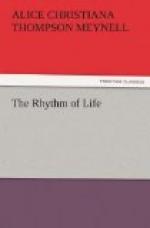I named Leech but now. He was, in all things essential, Dickens’s contemporary. And accordingly the married woman and her child are humiliated by his pencil; not grossly, but commonly. For him she is moderately and dully ridiculous. What delights him as humorous is that her husband—himself wearisome enough to die of—is weary of her, finds the time long, and tries to escape her. It amuses him that she should furtively spend money over her own dowdiness, to the annoyance of her husband, and that her husband should have no desire to adorn her, and that her mother should be intolerable. It pleases him that her baby, with enormous cheeks and a hideous rosette in its hat—a burlesque baby—should be a grotesque object of her love, for that too makes subtly for her abasement. Charles Keene, again—another contemporary, though he lived into a later and different time. He saw little else than common forms of human ignominy—indignities of civic physique, of stupid prosperity, of dress, of bearing. He transmits these things in greater proportion than he found them—whether for love of the humour of them, or by a kind of inverted disgust that is as eager as delight—one is not sure which is the impulse. The grossness of the vulgarities is rendered with a completeness that goes far to convince us of a certain sensitiveness of apprehension in the designer; and then again we get convinced that real apprehension—real apprehensiveness—would not have insisted upon such things, could not have lived with them through almost a whole career. There is one drawing in the Punch of years ago, in which Charles Keene achieved the nastiest thing possible to even the invention of that day. A drunken citizen, in the usual broadcloth, has gone to bed, fully dressed, with his boots on and his umbrella open, and the joke lies in the surprise awaiting, when she awakes, the wife asleep at his side in a nightcap. Every one who knows Keene’s work can imagine how the huge well-fed figure was drawn, and how the coat wrinkled across the back, and how the bourgeois whiskers were indicated. This obscene drawing is matched by many equally odious. Abject domesticity, ignominies of married life, of middle-age, of money-making; the old common jape against the mother-in-law; ill-dressed men with whisky—ill-dressed women with tempers; everything that is underbred and decivilised; abominable weddings: in one drawing a bridegroom with shambling sidelong legs asks his bride if she is nervous; she is a widow, and she answers, ‘No, never was.’ In all these things there is very little humour. Where Keene achieved fun was in the figures of his schoolboys. The hint of tenderness which in really fine work could never be absent from a man’s thought of a child or from his touch of one, however frolic or rowdy the subject in hand, is absolutely lacking in Keene’s designs; nevertheless, we acknowledge that here is humour. It is also in some of his clerical figures




